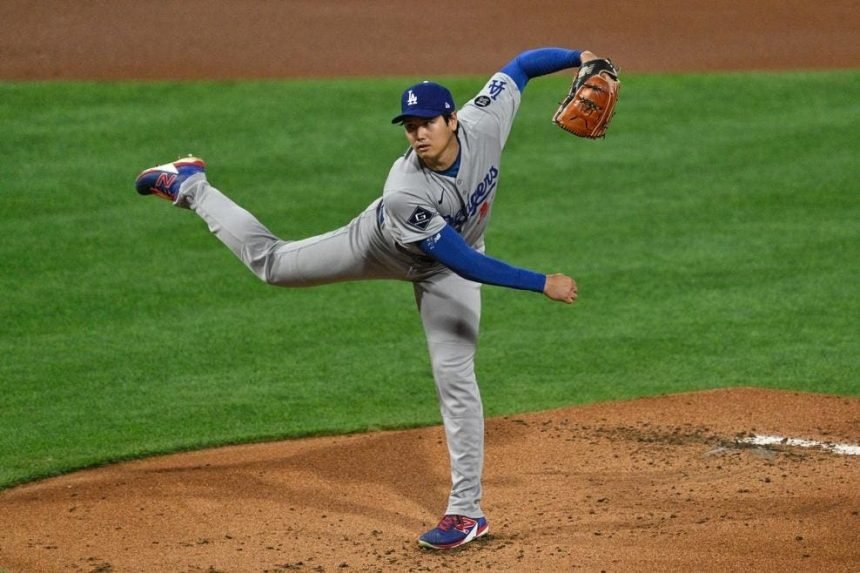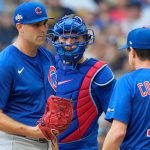PHILADELPHIA, PA – OCTOBER 04: Los Angeles Dodgers two-way player Shohei Ohtani #17 pitches the ball during the NLDS game between the Philadelphia Phillies and the Los Angeles Dodgers on October 4th, 2025 at Citizens Bank Park in Philadelphia, PA. (Photo by Terence Lewis/Icon Sportswire via Getty Images)
Icon Sportswire via Getty Images
PHILADELPHIA — In many ways, Saturday night’s performance by Shohei Ohtani, despite the historic nature of his achievement, fell short of the incredible standards he’s set for himself at the plate and on the mound in Los Angeles’ 5-3 win in Game 1 of the NLDS series against the Philadelphia Phillies.
After all, Ohtani, as leadoff hitter, struck out four times before reaching base in his final turn at bat with a walk, far from the 55 home runs he produced during the regular season. And his pitching line, which included three runs allowed in the second inning, was practically pedestrian over six innings — the bare minimum of a quality start.
All of which, taken as a referendum on the Shohei Ohtani Experience, suggests that perhaps his greatest accomplishment to date is to turn yet another first in baseball history into the given, and that on a night when he provided plenty of contributions to a vital road win for Los Angeles, many of the postgame questions to Ohtani and manager Dave Roberts centered on why he hadn’t done more.
The unprecedented night for Ohtani — leading off and starting on the mound had never happened in a playoff game, and the last time a starting pitcher in the postseason hit anywhere other than eighth or ninth in the order came in Game 4 of the 1918 World Series, accomplished by some guy named Babe Ruth — did not go unnoticed by his manager.
“Well, it’s certainly never been done, certainly at this level,” Roberts told me, sitting at the postgame podium following the game. “I think it just really speaks to, I use the word compartmentalize a lot, but this epitomizes compartmentalizing these essentially two people, in one night, in one game. To look at the at-bats he took tonight and how he struggled offensively, but to separate that and just be a pitcher, and whether that inning, that three-run inning, to then go out there and give us six innings, keep us in the ball game… I just don’t know any human that can manage that. Those emotions, and how do you not take that to the mound? So we’re just continuing to just witness history.”
PHILADELPHIA, PENNSYLVANIA – OCTOBER 04: Shohei Ohtani #17 of the Los Angeles Dodgers reacts in the ninth inning against the Philadelphia Phillies in game one of the Division Series at Citizens Bank Park on October 04, 2025 in Philadelphia, Pennsylvania. (Photo by Emilee Chinn/Getty Images)
Getty Images
Ohtani’s hitting did not live up to his typical performance, but it was his ability to right the ship on the mound that turned the game around. The Phillies took a 3-0 lead, aided by a two-run triple from J.T. Realmuto that split the outfielders in right-center field, and the Phillies threatened again in the fifth. Ohtani hit Harrison Bader, and Bryson Stott followed with a single, putting two runners on with one out. Prior to the game, Phillies manager Rob Thomson had said this was precisely why he’d chosen to hit Bader and Stott 8-9 in the order, to set the table for Trea Turner and Kyle Schwarber to follow.
Not only did Ohtani get Turner to line out, he followed with a strikeout of Schwarber on his curveball, an offering he uses less than 9% of the time. And tellingly: not a single Dodgers pitcher so much as got up to stretch in the bullpen. Roberts never wavered from Ohtani in that spot.
“I just felt that he was just getting better as the night went on,” Roberts said. “I thought he was the best option, and nothing that I was seeing showed a dropoff. And so, if he could chew up a couple more innings, I thought it would help us tonight and the games going forward.”
After giving way on the mound to Tyler Glasnow — the Dodgers indicated before the game that they’d likely view their starters as relievers, and between Glasnow and “closer” Roki Sasaki they proved that right away — Ohtani still played a vital part in the late-game strategy. He came up in the top of the ninth inning and walked slower than usual to the plate. He then showed bunt, rare for a two-time 50-homer hitter. (He does not have a sacrifice to his credit in 4,329 regular season at-bats.) He was, it seemed, determined to delay the proceedings as much as possible.
“I was told by Dave Roberts to make some time for Roki pitching in the bullpen, warming up. So I did,” Ohtani told me through his translator after the game with a sly grin. “I wanted to do everything in my power to make sure we got ample time for him.”
The gambit worked. Sasaki pitched a scoreless ninth, and as the great Sarah Langs pointed out, the second postseason game in MLB history with a Japanese duo earning both the win and the save was complete.
It’s just more history, which seems to follow every Shohei Ohtani accomplishment. But for Ohtani, getting to manifest the vision the Dodgers had when they signed him — an elite hitter and pitcher leading the charge for a postseason team — was more about about his identity than any spot in the record books.
“Yeah, the reason why I’m a two-way player is because that’s who I am and it’s what I can do, and also, at the same time, it’s what the team wants,” Ohtani said. “So that’s the reason why I’ve been doing this.”











